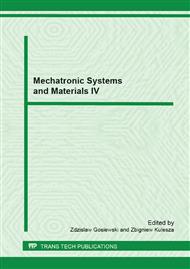[1]
J. M. Barandiaran, J. Gutierrez, Magnetoelastic sensors based on soft amorphous magnetic alloys. Sensors and Actuators A59 (1997) 38.
DOI: 10.1016/s0924-4247(97)80145-8
Google Scholar
[2]
J. Bydzovsky, L. Kraus, P. Svecc, M. Pasquale, Magnetoelastic strain sensors for the outdoors application. J. Magn. Magn. Mater. 272–276 (2004) e1743.
DOI: 10.1016/j.jmmm.2003.12.414
Google Scholar
[3]
Q. Y. Cai, C. A. Grimes, A remote query magnetoe-lastic pH sensor, Sensors and Actuators B 71 (2000) 112.
Google Scholar
[4]
A. Bieńkowski, R. Szewczyk, The possibility of utilizing the high permeability magnetic materials in construction of magnetoelastic stress and force sensors. Sensors and Actuators A113 (2004) 270.
DOI: 10.1016/j.sna.2004.01.010
Google Scholar
[5]
A. Bieńkowski, R. Szewczyk, J. Salach, Industrial application of magnetoelastic force and torque sen-sors. Acta Physica Polonica A, 118 (2010) 1008.
DOI: 10.12693/aphyspola.118.1008
Google Scholar
[6]
J. Bydzovsky, M. Kollar, V. Jancarik, P. Svec, L. Kraus, Strain sensor for civil engineering application based on CoFeCrSiB amorphous ribbons. Czechoslovak Journal of Physics, 52A (2002) A117.
DOI: 10.1007/s10582-002-0027-y
Google Scholar
[7]
A. Bieńkowski, J. Salach, R. Szewczyk, Urządzenie do zadawania naprężeń rozciągających do rdzenia pierścieniowego przetwornika magnetosprężystego. Zgłoszenie patentowe P-382475, (2007).
Google Scholar
[8]
J. Salach, R. Szewczyk, A. Bieńkowski, P. Frydrych, Methodology of testing the magnetoelastic characteristics of ring-shaped cores under uniform compressive and tensile stresses. Journal of Electrical Engineering, 61 (2010) 93.
DOI: 10.2478/thai-2013-0003
Google Scholar
[9]
M. J. Sablik, B. Augustyniak, M. Chmielewski, Mode-ling biaxial stress effects on magnetic hysteresis in steel with the field and stress axes noncoaxial. J. Appl. Phys. 85 (1999) 4391.
DOI: 10.1063/1.369794
Google Scholar
[10]
R. O'Handley, Modern magnetic materials – principles and applications. John Wiley & sons, (2000).
Google Scholar


